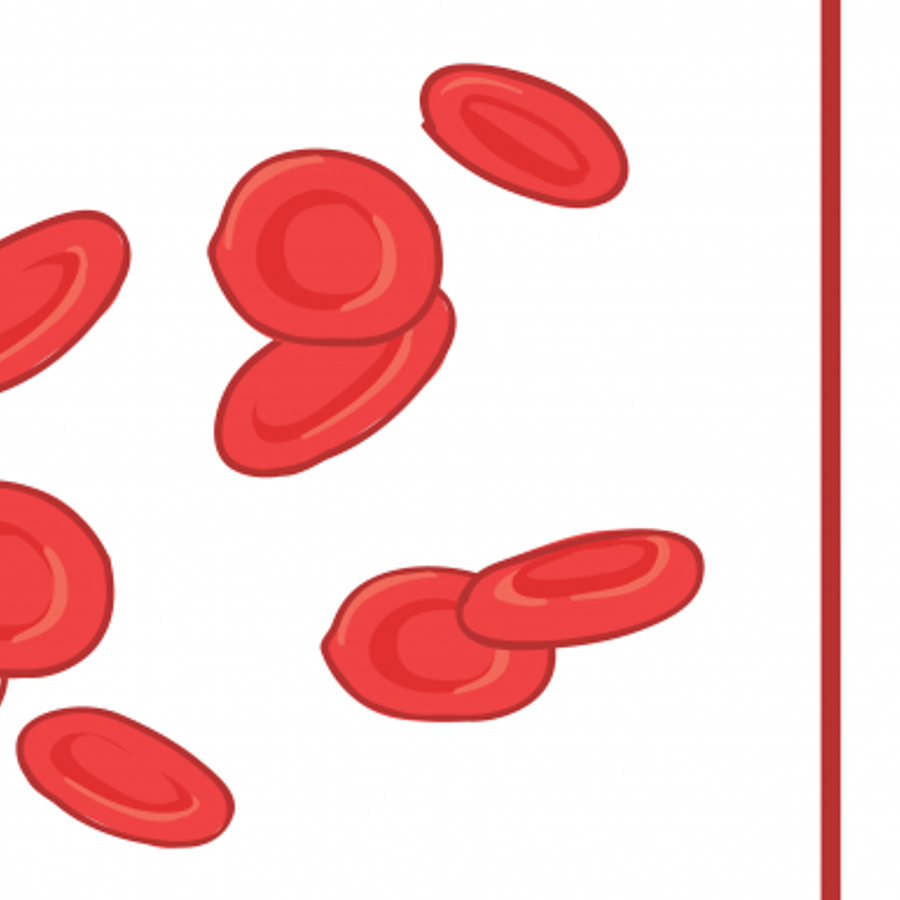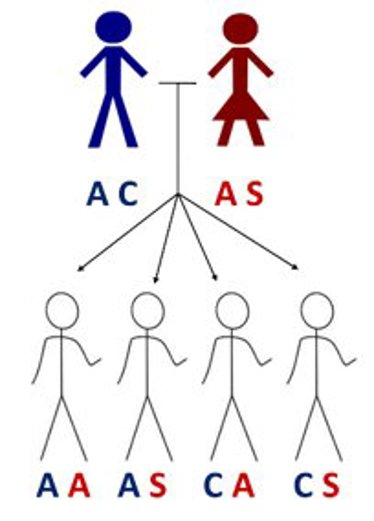
Is there any risk for a child whose parents are carriers for Hemoglobin C and sickle respectively?
October 1, 2013

A curious adult from Nigeria asks:
"What are the risks for the children of one parent who is a carrier for Hemoglobin C (AC) and the other is a carrier for sickle cell (AS)?"
The main risk is that one parent will pass the hemoglobin C and the other will pass the sickle cell to the same child. Each child has a 1 in 4 chance of ending up with this combination.
If this happens, the child will most likely have something called Hemoglobin Sickle C Disease (Hb SC disease). This may sound scary because of the word sickle in its name but it is not nearly as severe as sickle cell anemia.
People with Hb SC disease have red blood cells that can sometimes sickle and clog up small blood vessels and cause pain. This is similar to what happens in people with sickle cell anemia but it happens way less often and when it does, the pain doesn’t last as long and is much less severe.
The other issue with these blood cells is that they are a bit more fragile than other people’s cells. This means they tend to break more often which can lead to mild anemia.
There are other complications too but these can all be dealt with if caught in time. This is why frequent doctor visits as well as frequent visits with an ophthalmologist are very important for these people. Click here to learn more about some of the complications that come with this disease and what can be done to avoid them.
Of course, each child has just a 1 in 4 chance of ending up with Hb SC disease. They each also have a 3 in 4 chance of having very few issues with their red blood cells. And even if they end up being a carrier like one of their parents, they will have very few symptoms (and may even end up having a better chance of not getting malaria).
For the last bit, I want to talk about where those numbers came from. As you’ll see, it has to do with the fact that we have two copies of each of our genes and we pass only one to our kids.
Hemoglobin Gene
The instructions for making and running each of us can be found in the genes sprinkled throughout our DNA. Each of our 20,000 or so genes has the instructions for one small part of each of us.
So there is a gene that lets some people digest milk as an adult, another that decides if you’ll have red hair and so on. The one we are interested in today is the hemoglobin (Hb) gene.
The hemoglobin gene has the instructions for making the incredibly important hemoglobin protein. This protein, found in red blood cells, carries oxygen to and takes carbon dioxide away from every part of the body. Since we need it to survive, everyone alive makes hemoglobin.
Like lots of other genes, the Hb gene comes in different versions. For this answer, we need to focus on three of them — A, C, and S.
The A version is the common one and the one that most people have. Both the C and the S forms each have a different glitch in their hemoglobin instructions. The C version has a tiny change that under the right circumstances can lead to Hemoglobin C disease and the S version has a different tiny mistake that can sometimes lead to sickle cell anemia.
To understand what is going on in your example, we need to know a couple more things. The first is that we have two copies of each of our genes.
What this means here is that there are six possible combinations of the three forms of the hemoglobin gene we have been talking about. Here is a table showing those six and what effect each has:
|
Gene Combination |
Effect |
|
AA |
Normal |
|
AC |
Hemoglobin C carrier |
|
AS |
Sickle cell carrier |
|
CC |
Hemoglobin C Disease |
|
CS |
Hemoglobin Sickle cell Disease |
|
SS |
Sickle cell anemia |
For the situation here, we have an AC parent and an AS parent. One is a carrier for Hemoglobin C disease and the other is a carrier for sickle cell anemia. They have very few symptoms but do each have a hidden gene that under the right circumstances can cause problems for their future kids.
We are almost ready to explain why each child has a 25% chance of ending up with Hemoglobin Sickle C Disease. To do that, we need to understand just one more thing…
Parents Pass One Copy of Each Gene to Their Kids
As I said, we all have two copies of most of our genes. The way we end up with two is that each egg and sperm only have a single copy. When the two combine, we get back to the original two copies.
Which copy gets put into a sperm or egg is completely random. What this means is that the AC parent will pass an A down half the time and a C the other half of the time. The AS parent will pass an A half the time and an S the other half of the time.
When we do all the possible combinations, we end up with an equal chance for the following four:

In this picture, the dad (in blue) is AC and the mom (in red) is AS (it works in reverse too). He is a carrier for Hemoglobin C and she is a carrier for sickle cell.
Each child has a 50% chance of getting an A from dad and a 50% chance of getting a C. This is shown with the blue letters…the first two got an A and the second two a C.
Each child also has a 50% chance of getting an A and a 50% chance of getting a C from mom. This is shown with the red letters. The first and third child got an A and the second and fourth got an S.
The end result is the four combinations you see — AA, AS, CA, CS (CA is the same as AC). The fourth possibility, CS, will almost certainly have Hemoglobin Sickle C Disease (Hb SC disease).
The other three possibilities are either completely or mostly unaffected. The first one doesn’t carry anything, the second carries sickle cell anemia and the third Hemoglobin C. All of these kids are pretty much disease-free.
So that is where the 1 in 4 number for Hb SC disease. Each parent has a 50% chance of passing down a glitchy hemoglobin gene and if they both do, the child will end up with Hb SC disease.

Author: Dr. D. Barry Starr
Barry served as The Tech Geneticist from 2002-2018. He founded Ask-a-Geneticist, answered thousands of questions submitted by people from all around the world, and oversaw and edited all articles published during his tenure. AAG is part of the Stanford at The Tech program, which brings Stanford scientists to The Tech to answer questions for this site, as well as to run science activities with visitors at The Tech Interactive in downtown San Jose.
 Skip Navigation
Skip Navigation
